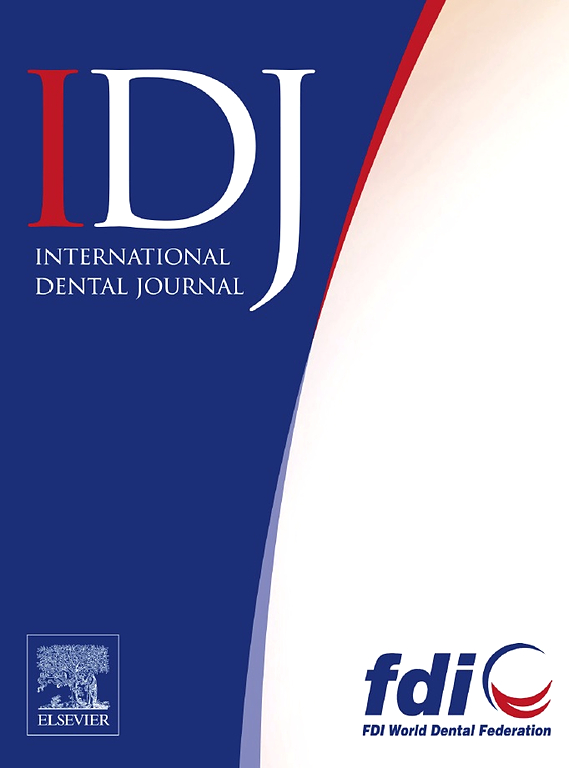稳定夹板治疗后颞下颌关节变化的三维综合评价
IF 3.7
3区 医学
Q1 DENTISTRY, ORAL SURGERY & MEDICINE
引用次数: 0
摘要
虽然稳定夹板(SSs)已显示出治疗颞下颌关节疾病(TMDs)的良好效果,但有必要对其治疗后颞下颌关节(TMJ)的变化进行全面的研究。本研究旨在通过先进的三维评估和形状对应分析来评估TMD患者TMJ结构、位置和髁重构的变化。方法回顾性研究80例接受SS治疗的成人TMD(关节痛)患者,采用三维切片软件对治疗前后的锥形束计算机断层扫描结果进行分析。评估了以下测量结果:(1)髁突体积变化,(2)骨密度,(3)关节间隙,(4)髁突位置,(5)髁突旋转,(6)髁突重塑(吸收或移位)。通过配对t检验和Wilcoxon秩和检验对时间点和髁侧进行统计学比较。结果治疗时间6 ~ 12个月,平均9.8个月。研究结果显示,髁突体积和骨密度略有增加,但无统计学意义的变化。然而,在两侧的前关节间隙中发现了显著的差异。髁突位置改变表现为下、外侧和前向平移,以及两侧向前旋转运动。局部髁重构显示骨形成主要在后侧和上侧区域,而轻度骨吸收主要在前内侧和内侧区域。结论ss治疗可促进良好的髁重构和TMJ复位,其表现为关节前间隙缩小、前下髁移位、前旋改变以及局部骨移位。这些发现强调了它在促进TMD患者适应性改变中的作用。本研究表明,SS治疗可改善TMJ功能和髁突动力学,提供了一种无创治疗选择,可减少机械应力并提高患者预后。这些见解为临床医生将SS治疗纳入TMD管理策略提供了有价值的证据。本文章由计算机程序翻译,如有差异,请以英文原文为准。
Comprehensive Three-Dimensional Evaluation of Temporomandibular Joint Changes Following Stabilization Splint Therapy
Introduction and aims
While stabilization splints (SSs) have shown promising therapeutic effects for temporomandibular disorders (TMDs), comprehensive studies evaluating temporomandibular joint (TMJ) changes following SS therapy are necessary. This study aimed to assess TMJ structural, positional, and condylar remodelling changes in TMD patients by using advanced three-dimensional assessment and shape correspondence analysis.
Methods
This retrospective study included 80 adult TMD (arthralgia) patients treated with SS. Pre- and post-treatment cone beam computed tomography scans were analysed using three-dimensional Slicer software. The following measurements were evaluated: (1) volumetric condylar changes, (2) bone mineral density, (3) joint spaces, (4) condylar position, (5) condylar rotation, and (6) condylar remodelling (resorption or apposition). Statistical comparisons between time points and condylar sides were performed via paired t tests and Wilcoxon rank-sum tests.
Results
Treatment duration was 6 to 12 months (mean: 9.8 months). Study results indicated a slight increase in condylar volume and bone mineral density, but no statistically significant changes were observed. However, significant differences were noted in the anterior joint space on both sides. Condylar positional changes demonstrated inferior, lateral, and anterior translation, along with forward rotational movement on both sides. Localized condylar remodelling revealed bone formation predominantly in the posterior and superior regions, while slight bone resorption was mainly observed in the anteromedial and medial regions.
Conclusions
SS therapy promotes favourable condylar remodelling and TMJ realignment, as evidenced by reduced anterior joint space, anterior-inferior condylar displacement, and forward rotational changes, along with localized bone apposition. These findings highlight its role in facilitating adaptive changes in patients with TMD.
Clinical relevance
This study demonstrates that SS therapy improves TMJ function and condylar dynamics, offering a noninvasive treatment option that reduces mechanical stress and enhances patient outcomes. These insights provide clinicians with valuable evidence for incorporating SS therapy into TMD management strategies.
求助全文
通过发布文献求助,成功后即可免费获取论文全文。
去求助
来源期刊

International dental journal
医学-牙科与口腔外科
CiteScore
4.80
自引率
6.10%
发文量
159
审稿时长
63 days
期刊介绍:
The International Dental Journal features peer-reviewed, scientific articles relevant to international oral health issues, as well as practical, informative articles aimed at clinicians.
 求助内容:
求助内容: 应助结果提醒方式:
应助结果提醒方式:


